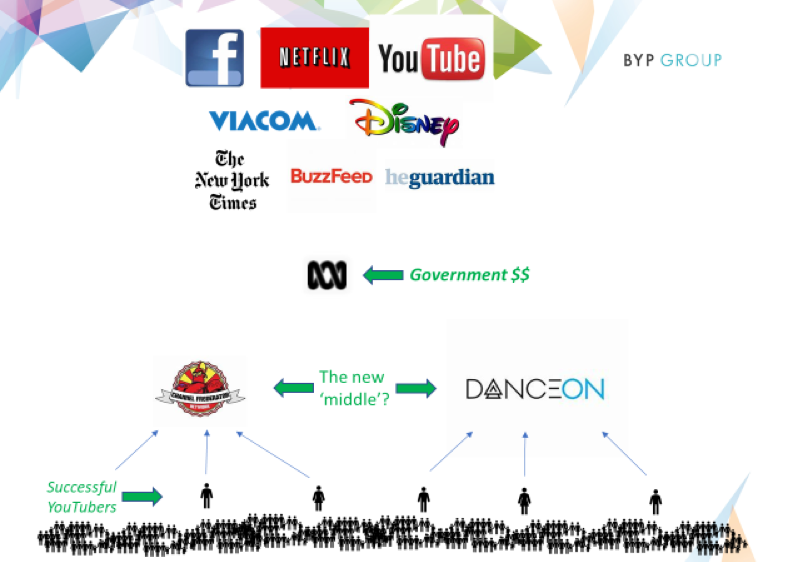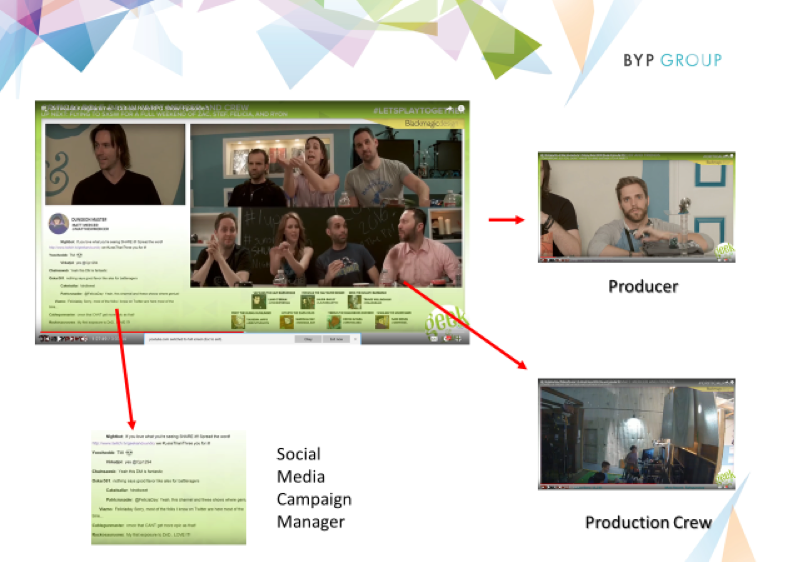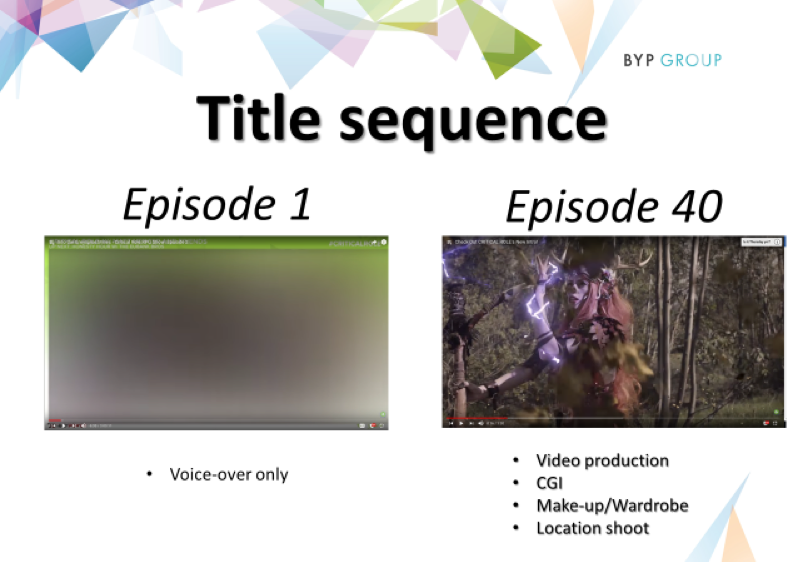In this section, we will look at some examples of ‘New Media’ business models that are being employed to harness the Internet to allow scale for small creative businesses. This is the third of a series of blogposts that examines ramifications of the small size of most Australia creative businesses and explores strategies for resolving issues raised here.
In the previous blogs, we explored:
Part 1: We’re Tiny. The tiny size of Australian creative industries
In future blogs, we will look at:
Part 4: Australian creative economy needs, especially those in the arts and cultural sector
Part 5: How a new media model solution might look in the arts and cultural sector
Part 3: New Media Business Models
Business Models for the Small Creative Business in the New Media Paradigm
But what business models are the small content creators – similar to our independent artists and small arts organisations – employing to survive?
Diagram above: Old vs New Paradigm. What is happening down in the bottom right, between the independent creators and ‘middle-tier’?
Before we answer this question, we need to take a closer look at what’s happening in that gap between the middle tier and the bottom.
Diagram above: Virtually anyone can post content to the Web now. A few may make a living from it. A small percentage of YouTubers generate an income from their YouTube channels.
At the bottom of the above diagram, we see very few people make a viable living from their content. This is not new. Very few people as a percentage of the population ever made a living from the traditional TV/Film industries. What is more, these YouTube content creators experience much greater creative freedom in what they do and create than most of the traditional TV/Film industry workers who tended to be crew, or producers making content for a broader mainstream audience e.g. broadcast content, international film productions. In fact, we argue that finding one’s ‘authentic voice’ (an artist’s unique selling point, or USP, if you like) is imperative to the small, online, content creator.
Still, it’s undoubtedly difficult for individual content makers to make a living from an aggregator like YouTube. Successful YouTubers generally require investing 50 to 60 hours a week on content production, and even then, it usually takes years to build a subscriber base (‘audience’) sufficient to make a living.
Their problem, as it is in the independent arts scene, is one of scale. It takes them so long to make content that they have little time to spend on other monetization activities such as merchandizing, spin-off services (e.g. consulting) and experiential content (live, ticketed performances), or other audience development work e.g. marketing, conference attendance etc. They frequently also need to focus upon just one aggregator or platform (in this case, YouTube) to create enough scale to draw an audience. This makes financial sustainability ever harder for the independent as others flood in due to low barriers to entry, and also very vulnerable to the platform on which they choose to concentrate their activity (to achieve ‘cut-through’ amongst the noise). We saw this recently with the ‘Ad-pocalypse’ decimating YouTube ad revenues and that of YouTubers who had chosen to monetize their content through YouTube.
What has the market done to find solutions to this problem of scale in the new paradigm?
The answer lies in two overlapping business models:
1) The Multi-Channel Network (or MCN) and
2) The Online Original Content Channel (OOCC).
Multi-Channel Networks and Original Content Channels
Diagram above: Where new screen business models fit in the new ecosystem. Notice how they occupy a new 'lower-middle' tier between the old paradigm 'middle' (e.g. broadcast networks, national newspapers) and the bottom.
Image above: On the left, the Multi-Channel Network. On the right, the Online Original Content Channel
Note these definitions are not precise as the sector is undergoing disruption and transformation. In fact, the Online Original Content Channel is my own name and definition for one of the new business models. For the time being, let’s outline the two different approaches:
1) Multi-Channel Networks (or MCN’s)
The first – MCN’s – aim to provide marketing and advocacy scale, whilst generally not becoming involved in content production. i.e. They have no ‘skin in the game’.
A good example of an MCN operating in this mould is The Channel Frederator Network: http://www.channelfrederatornetwork.com/
Note the splash page of the Channel Frederator Network’s (in the above diagram on the left). It emphasises the big numbers it attracts – without even a reference to the type of content on its site.
Its business model is one of undifferentiated content aggregation.
2) Online Original Content Channels (OOCC’s)
OOCC’s on the other hand, do create their own content, or at the very least, seek to contribute to the production of the content and curateit, by offering economies of scale in things such as, production crew, social media campaign managers, booking agents, studio facilities etc. Whilst an MCN as large as the Channel Frederator Network (above) might also offer these things, the OOCC seeks to aggregate and offer scale in a niche.
Note this latter model differs from the YouTube Spaces model in that the OOCC is not simply a ‘neutral’ or ‘objective’ provider of resources on plainly economically rational grounds. Whilst an OOCC may, of course, measure its ‘sub-channel’ content according to rational measures, it bears substantially more risk than YouTube or an MCN does by investing in the content production. YouTube Spaces is like a ‘macro’ model of an OOCC, with YouTube benefitting overall from the improvement in production values and capabilities of videos posted on its site. Because YouTube owns the aggregation site, it does not need to differentiate in content. MCN’s are like ‘mini’ YouTube Spaces.
OOCC’s, on the other hand, almost always pursue a niche strategy. As we described in Part 1 of this blog series, niche strategies are important to survive if you are a small plant or animal in the big jungle. It is the orthodox business strategy for small players within and outside the creative sector: Where competition is fierce, and you are small, you must make sure what you do provides unique value in that ecosystem, or you will quickly find your margins eroded by another competitor e.g. a competitor from a country where costs are lower e.g. India, Nigeria, China etc. We describe more on the niche strategy below as it applies to two different OOCC’s in Part 5, ‘Example: The importance of niche’.
What does an OOCC look like?
Starting from the outside looking in, generally, an OOCC will occupy multiple platforms and aggregators (e.g. website, iOS, Twitch, Facebook Live, YouTube, podcasts, etc) to maximise distribution of its content – one of its advantages over a small YouTube operation. Within an aggregator, such as YouTube, the OOCC will have many ‘sub-channels’, visible on its ‘Playlist’ tab (right hand side of the screen shot below).
Images above: What an OOCC looks like from the outside. Top: Home page on the web of an OOCC. Bottom left: Splash page for the OOCC on YouTube. Bottom right: The OOCC’s sub-channel menu with each of the images representing a sub-channel of content, like a television program on television.
What do they look like from the inside? Here we’re going to focus on the OOCC called Geek & Sundry. Some features to note:
The content is produced in the studio of the OOCC using (initially) the OOCC’s generic set, production crew (producer, camera, audio and social media manager). One might wonder how they can afford the staff and crew. The answer is that these same crew and resources are scaled across the large number of sub-channels (see the above diagram in the bottom right image), likely using the same crews and resources across different sub-channel productions. ‘Sub-channels’ are defined here as channels of content that have been curated by the OOCC and exist under the banner of the main online channel – here, a YouTube channel. Similarly, the sub-channel might exist on the OOCC’s website under a separate tab or link.
So what are the consequences of this scaled approach at the micro-level? In the next few diagrams we’ll look at one of the sub-channels – Critical Role (which exists on the OOCC, Geek and Sundry) – and watch how it benefits from scale, starting from its humble start as a very bare-bones production. Later, we’ll compare it to an unscaled YouTube sub-channel, and also compare it to an unscaled artist or arts organisation approach.
Example: Critical Role Sub-Channel. Critical Role is a sub-channel on the Geek & Sundry OOCC. Note, the Geek & Sundry logo appears on the bottom right of the screen, visible in the images at the top left, top right and bottom right.
The Benefits of Scale for an OOCC
The first thing to note below is the title sequence of the same sub-channel at different times in its journey: For Episode 1, there is no visual title sequence – just voice over. After approximately 40 episodes we can see elaborate make-up, wardrobe, CGI, location shoot etc.
Diagram above: The first episode title sequence is nothing but a blurred screen with voice-over. By episode 40, the program/sub-channel has earned enough subscribers, monetisation or engagement (the OOCC sets the Key Performance Indicator) to afford a video production with CGI (provided by a sponsor), make-up/wardrobe and a location shoot.
As the sub-channel grows, it has attracted more sponsors. Note below the hand-drawn diagram/map in the left picture compared to the ornate models and figurines being used on the right. These products have been provided by sponsors, demonstrating one of the advantages of scale (and success).
Diagram above: Product placement advantage for an OOCC sub-channel. On the left props and set are generic or cheaply drawn. On the right, as the sub-channel grows, it attracts sponsors, in this case, figurines and elaborate models.
Also note above, the use of the OOCC’s generic set in the early episodes has been replaced by a customised set build as the sub-channel has earned the resource allocation through subscriber growth and views. Note too, some of the talent are wearing t-shirts and other paraphernalia branded for the sub-channel. They are able to produce, promote and sell merchandise and promote sponsors much more easily due to their scale, probably through a dedicated sponsorship manager and/or online community manager. In the first instance though, before the sub-channel has proven itself, the online community and campaign manager was probably the producer and their (the talent’s) own efforts, as with a normal unscaled Youtuber’s channel.
Comparison of a scaled OOCC sub-channel versus an unscaled OOCC sub-channel
Now we compare an unscaled OOCC sub-channel (below image, on the left) to the scaled sub-channel (below image, on the right, which is still the Critical Role example from before). Although the lone YouTuber on the left has strong graphic and video production skills (he came from the video production industry) – possibly even better than for the ‘Critical Role’ sub-channel - he cannot beat the better production values over time or the access to a wider talent pool.
Diagram: Comparison of unscaled sub-channel versus a scaled sub-channel
In fact, we are also seeing another benefit of the scaled operation. In the above example, the OOCC was using the popularity of one sub-channel to cross-promote and publicize the launch of what would become a new sub-channel on the OOCC: D&Diesel.
Audience engagement and development
In the image below, on the left, the lone (‘unscaled’) YouTuber is able to gather his friends together for a livestream with his audience. In the image below, on the right, a professional ‘gig booker’ has taken the Critical Role talent around the United States before live audiences of hundreds, sometimes thousands. These are opportunities to either further monetize e.g. paid tickets, or develop new audience and engage more deeply with existing audience.
Diagram above: The scaled program on the right is before an audience of hundreds. This audience can be monetised (selling tickets to the event - a live-before-an-audience performance of what the program streams) or used to build audience and deepen engagement.
Comparison of Spin-off IP monetization
Below, both the sub-channels being compared have ‘spin-off’ intellectual property (IP) they wish to monetize. The ‘Z-Land’ content from the unscaled OOCC is based on their original IP for a new game system. But with viewer numbers only in the dozens, it is probably not selling anywhere near as well as the IP generated by the other ‘scaled’ sub-channel, Critical Role.
Below, one of the talents on the ‘Critical Role’ show, the Chronicles of Exandria, due to its audience of millions: https://geekandsundry.com/the-chronicles-of-exandria-the-tale-of-vox-machina-available-now/ (and also likely due to the fact that the critical role IP to serve an already well-known IP asset, Dungeons & Dragons).
Diagram above: Comparison of spin-off IP monetization capabilities between unscaled sub-channel and scaled sub-channel
Monetization ratios
A key performance indicator (KPI) to examine is the comparison between monetization ratios of scaled OOCC operations and unscaled OOCC’s.
Image: Comparison of monetization ratios between unscaled sub-channel and scaled sub-channel. Very rough estimates for monetization per YouTube subscriber.
Unfortunately, this is a difficult exercise from where we stand. It is difficult to specify precise monetization ratios for YouTube channels because:-
1) It is a confidential stipulation of YouTube that content creators using its services not disclose monetization rates
2) The KPI monetized by YouTube is the amount/duration of ads viewed by viewers (‘Clicks per 1000 views’ or CPM). This will vary even within a YouTuber’s own channel as content length and type may vary
3) Many OOCC’s are privately held and keep data to themselves
BYP Group estimates - very roughly - that the average successful YouTuber (say, >10,000 subscribers – it’s what YouTube itself uses as a gauge for access to resources at its YouTube Spaces) monetizes at a ratio of around $0.33c per subscriber from YouTube ad revenue alone (the YouTuber gets 45%, and YouTube keeps 55%). If they actively undertake activities such as merchandising and spin-off services, they may reach $1 per subscriber and possibly higher. For reasons of scale mentioned above, we suspect few lone YouTubers ever achieve this higher threshold.
A scaled OOCC is likely to generate a much better monetization ratio. To put that in context, recall Geek & Sundry had 1.7 million (now nearly 1.8M) subscribers. We roughly estimate G&S’s revenue is around $8-17 million p.a.
In the next section, we examine the needs of the Australian creative industries, with a particular emphasis on the arts and cultural sector. We do this with a view to seeing how the business models explored above might fit with the needs of our sector.












